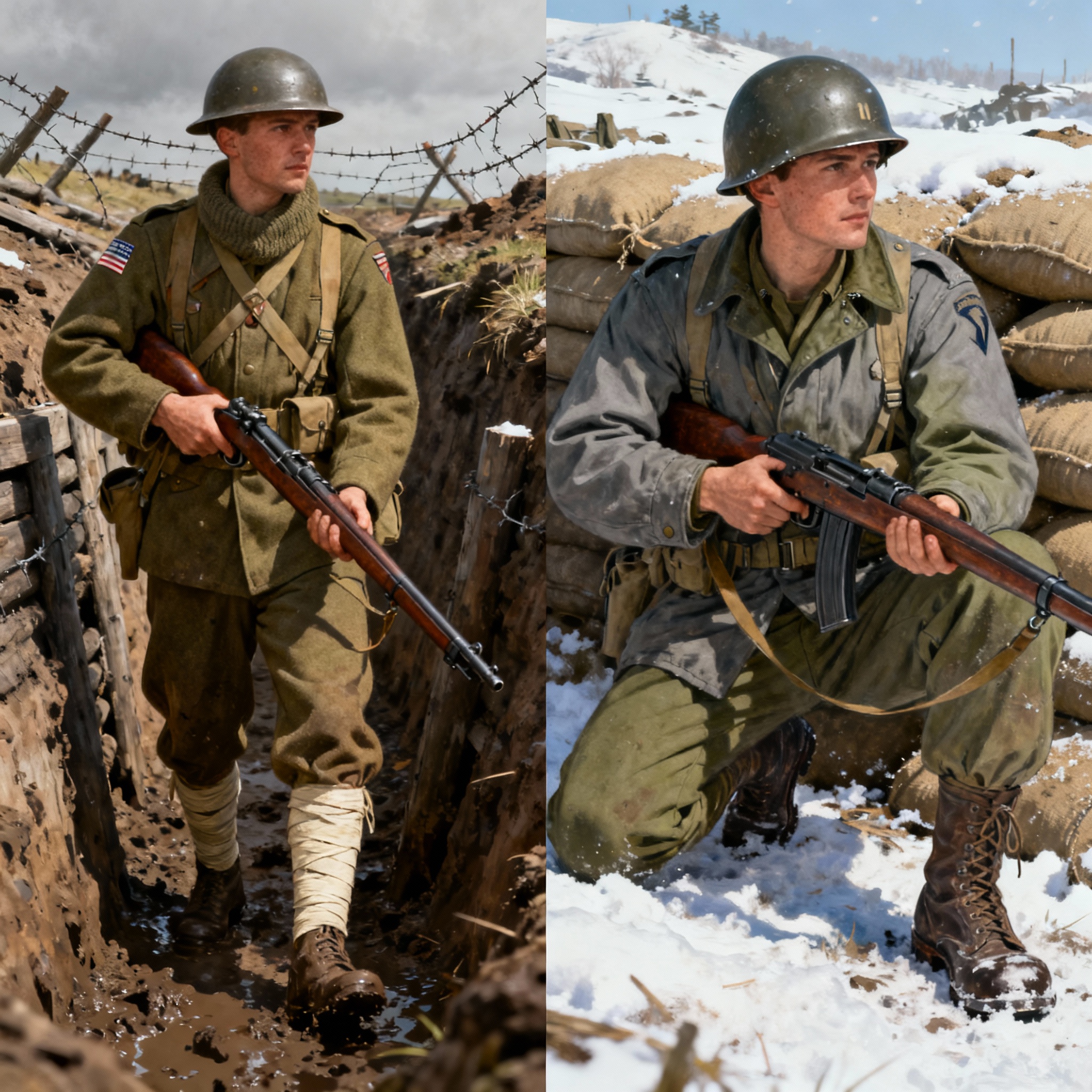
From WWI Trenches to Korean Battlefields: Uniforms in Transition
Published on Oct 04, 2025
🪖 From Trenches to Tactics: How Korean War Uniforms Evolved from World War 1 Uniforms United States Gear
🧠 Did You Know?
Over 1.7 million Americans served during the Korean War—yet most collectors overlook their uniforms compared to World War 1 or World War II gear.
Are you fascinated by the evolution of military uniforms and the stories they tell? Whether you're a seasoned collector or just diving into military history, understanding the shift from World War 1 uniforms in the United States to Korean War attire is key.
In this guide, you'll:
- Discover how U.S. military uniforms evolved between wars
- Learn how to identify, collect, and care for Korean War uniforms
- Avoid common mistakes when purchasing authentic pieces
- Keep up with current trends in the military collectibles market
Let’s gear up!
🏛️ A Brief History: From Doughboys to Dogfaces
The evolution from World War 1 uniforms United States soldiers wore to the more modern designs of the Korean War reflects not just fashion, but battlefield necessity.
🪖 World War 1 Uniforms United States: Key Characteristics
- Wool fabric for warmth in trench conditions
- Olive drab color (OD Green)
- Distinctive M1912 tunic with standing collar
- Breeches and wrap leggings
- Metal buttons, shoulder patches, and sometimes unit insignia
These early uniforms were rugged but not designed for comfort or flexibility.
⚙️ United States Army Uniforms WW1: Notable Issues
- Heavy materials that became unbearable in wet conditions
- Poor ventilation in warmer climates
- Complicated layering system that required frequent adjustments
🧥 Korean War Uniforms: Function Meets Form
The Korean War (1950–1953) demanded fast adaptation to a new type of warfare — mobile, mountainous, and freezing cold.
✅ What Changed?
- Introduction of the M-1951 field jacket, based on WWII models but insulated and redesigned for Korean winters.
- Layering systems (undershirts, field jackets, parkas) to improve comfort and flexibility.
- Trousers with integrated suspenders and improved insulation
- Combat boots with rubber soles and leather uppers for better grip in snow and mud
🧭 Actionable Steps to Start Your Own Korean War Uniform Collection
Interested in building your own display or reenactment outfit? Here’s how to get started:
1. 📚 Learn the Basics
Familiarize yourself with standard-issue items:
- M-1951 field jacket
- Wool shirts and trousers
- M1 helmet (carried over from World War II American uniforms)
- OG-107 fatigues (later in the war)
2. 🔍 Know What to Look For
When evaluating a uniform or piece of gear:
- Check for dated tags inside garments (often reads “1951” or “1952”)
- Inspect stitching and buttons for wear and age
- Look for unit markings or service numbers for added value
3. 🛒 Where to Buy
- Military surplus stores (online and physical)
- Auction websites like eBay
- Specialty military fairs and collector shows
- Reputable vintage uniform dealers
Tip: Always compare listings with reference photos from trusted historical sources.
⚠️ Common Pitfalls in Collecting Korean War and United States WW1 Uniforms
Avoid these common beginner mistakes:
❌ Mistaking Reproductions for Originals
Many WWI and Korean War uniforms have been replicated for reenactments. These often:
- Use synthetic fabrics
- Lack proper labels or date stamps
- Show no signs of wear
❌ Overpaying for Incomplete Sets
Always research market value and item condition. A complete Korean War uniform can cost anywhere from $150 to over $1,000, depending on rarity and condition.
❌ Neglecting Condition
Moth holes, fabric tears, or replaced parts drastically reduce value—especially for U.S. WWI uniforms, which were often made from moth-prone wool.
🔥 Trends in Collecting Korean War and World War II American Uniforms
Military collectibles have boomed in recent years, but here’s what’s trending now:
📈 Korean War Collectibles Are Gaining Value
Previously overlooked, Korean War gear is increasingly seen as the “next frontier” for collectors.
🧵 Restoration & Display
- Restoring original uniforms for museum-quality displays is becoming more popular.
- Shadow box framing and mannequins are being used to create lifelike home exhibitions.
📸 Reenactment & Photography
A growing community uses Korean War and United States WW1 uniforms for:
- Historical reenactments
- Period photography
- YouTube and TikTok history content
🛠️ Comparing Korean War vs. World War 1: United States Gear
Feature WW1 U.S. Uniform Korean War Uniform Fabric | Heavy wool | Cotton, nylon, wool blends
Jacket Style | M1912 or M1917 tunic | M-1951 field jacket
Headgear | M1917 "Brodie" helmet | M1 steel helmet (WWII carryover)
Footwear | Leather boots with leggings | Combat boots with rubber soles
Functionality | Basic, stiff, limited mobility | Layered, insulated, weather-adaptable
Color | Olive Drab | Olive Green (OG-107)
🗂️ How to Verify Authenticity: Pro Tips for U.S. WWI Uniforms
Spotting a genuine United States WW1 uniform is easier when you follow these tips:
- Look for label stamps inside the collar (often with year and manufacturer)
- Verify the cut of the tunic—WWI jackets have a very distinct boxy shape
- Compare buttons with reference guides—originals will be dull brass, not shiny
- Avoid uniforms with Velcro—a modern reproduction giveaway!
🎯 Final Thoughts: Why World War 1 Uniforms United States Styles Still Matter
Even as Korean War gear gains traction, World War 1 uniforms in the United States remain the foundation of American military uniform history. The contrast between stiff, trench-ready gear and mobile, weather-adapted Korean War uniforms tells the story of military evolution and human ingenuity.
